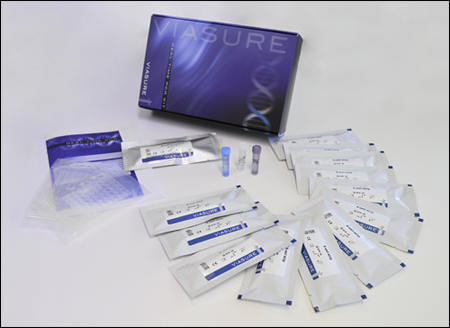
VIASURE Real Time PCR Detection Kits
Campylobacter coli, C. lari & C. jejuni

Description
VIASURE Campylobacter coli, C. lari & C. jejuni Real Time PCR Detection Kit is designed for the specific identification and differentiation of Campylobacter coli, Campylobacter lari and/or Campylobacter jejuni in human stool samples from patients with signs and symptoms of gastrointestinal infection.
This test is intended to be used as an aid in the diagnosis of C. coli, C. lari and/or C. jejuni in combination with clinical and epidemiological risk factors.
DNA is extracted from specimens, multiplied using Real Time amplification and detected using fluorescent reporter dye probes specific for C. coli, C. lari and C. jejuni.
Specifications
Information
Campylobacter species are gram-negative, nonspore forming, spiral, or curved-shaped bacteria. Among the more than 26 species currently classified in the Campylobacter genus, most human diseases are attributed to three major food-borne species: Campylobacter jejuni, Campylobacter coli, and Campylobacter lari. These three species can be isolated from poultry and are of greatest concern to the poultry industry.
Campylobacter is considered one of the most common causes of diarrheal illness worldwide. Poultry is a major reservoir and source of transmission of Campylobacter to humans. In particular C. jejuni is the common species found in beef, C. coli is often isolated from pork, and C. lari is predominant in shorebirds. Other risk factors include consumption of animal products and water, contact with animals, and even person-to-person transmission (fecal-oral or via fomites).
Infection with Campylobacter causes gastroenteritis characterised by fever, vomiting, headaches, and abdominal pain with watery or bloody diarrhea, for a median duration of 6 days. Besides gastroenteritis, these three species can cause periodontitis, septicemia, and second trimester intrauterine growth restriction. Furthermore, C. jejuni infection may lead to autoimmune conditions such as Guillain-Barré syndrome (GBS) and Miller Fisher syndrome (MFS).
Campylobacter enteritis is usually self-limiting and typically does not require antimicrobial therapy. In these cases, maintenance of proper hydration and electrolyte balance is the most important tenets of treatment. However, in severe and prolonged cases of enteritis, bacteremia, or other extraintestinal infection, prompt antimicrobial treatment is indicated.
Traditional microbiological methods for Campylobacter identification include enrichment, culturing, isolation, and phenotypic characterization. The procedures are laborintensive, time consuming, and with a relatively narrow differentiation spectrum among target species. These factors present challenges for the identification of Campylobacter from patient samples or contaminated food. Fortunately, methodologies based on molecular biology have been developed to improve laboratory approaches, such as Real. Time PCR. Multiplex qPCR can detect several targets in one reaction, saving time, effort, and sample. This qPCR assay can be used for identifying C. coli, C. lari and C. jejuni or secondary screening for confirmation of Campylobacter bacteria to the species level.
